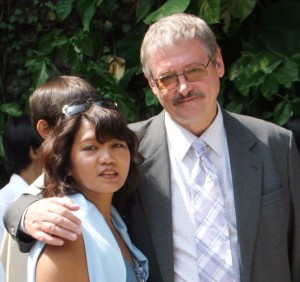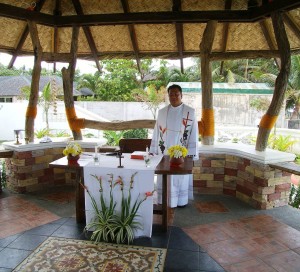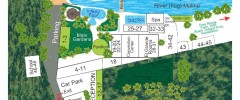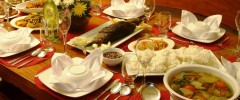Practical Tips for ‘Surviving’ the Philippines
INTRODUCTION

Punta Riviera Del Mar Resort is owned, has been developed, and is now managed by my wife Aileen (Emilyn) Respicio and myself Ir.Dr Ian McFeat-Smith. Most of the resort has been built using local labour and materials and supervised by ourselves from 2005 acting as the Architect, the Engineer, the Landscape Architect as well as Interior Designer. Our efforts, based upon no particular previous experience, have been directed by the unusual tenacity of Aileen and the help of various members of the Respicio family.
Management of the Resort (with Aileen as chief cook and purchasing officer) is carried out by ourselves and our Operations Manager Anjo to whom we owe thanks for his management skills and flair for organizing, family reunions, weddings, company outings, and running our Bolinao Lighthouse School for Tourism and Learning Centre, to Elvie Carolino and to Lydia Respicio and Benjie as our dedicated hard working senior staff. At present we employ 54 staff many of whom have stayed with us as the resort and its facilities have developed.
People
Similarities exist between the Scottish and Filipino (male gr.) peoples. Whilst Filipinas (female gr.) are busy colonizing the world today with hard work, a friendly nature and a smile the Scots as hardy folk living in tough environment provided the backbone of the world’s greatest and largest empire todate (see The Scottish Empire by Prof. Tom Devine).
We like to think that Punta Riviera Resort brings together the best of both of these great peoples.
ABOUT THE PHILIPPINES
The aim of his short review is to encourage you, as potential tourists to take an interest in the fascinating and unusual history, culture and environment into which you will be traveling and residing. No attempt is made to provide a comprehensive review which can be obtained by purchasing Lonely Planets book for traveling within the Philippines and do’s and don’ts In the Philippines by Book Promotion & Service Co. Ltd as we did. We also draw from a long period of traveling to beach areas in Luzon Island in particular when we were seeking a site on which to develop our retirement home, which, through the foresight of Aileen was developed into the resort instead.
The Philippines is a country of natural beauty, substantial development potential, resources and a population
of 90+M people with unusual cultural features that will help realize its full potential one day. It consists of over 7,000 islands the main one being Luzon on which Manila is located. The Resort is located in a village environment along the coast near Bolinao, Pangasinan Province some 5 hours drive to the North of Manila. Manila has too many vehicles and consequently can be a nightmare to drive through (from 6am to 11pm) so if possible, arrive late at night or fly direct to Clark/ Angeles City Airport to avoid wasting time sitting in heavy traffic.
Potted History
The indigenous inhabitants of the Philippines are called Negritos. Although little historical evidence is available it is understood that Malays and Indonesians arrived about 3,000 years B.C. These were followed by the Chinese traders from about 500 A.D. and by Islamic Arabs in about 1200 A.D. who settled in the South of the Philippines mainly on Mindanao Island. These were succeeded by the Spanish in 1500 A.D. who converted the inhabitants to Catholicism.
In the late 1800’s Jose Rizal through his writings and subsequent execution in 1896 inspired uprisings and revolt against the Spanish Government and Church due to their excesses at that time. In 1898 Spain sold the Philippines to the USA who in 1901 quelled the Filipinos in the Philippine – American War of Independence. In 1935 President Roxas was elected as the first Filipino president of a new Commonwealth Government.
The Japanese invaded the Philippines in 1942 and the country was liberated in 1944 by the USA. In 1946 the USA finally granted full Independence to the Republic of the Philippines. Martial Law was declared in 1972 by President Marcos. In 1986 Marcos was exiled in the USA and President Corazon Aquino elected. Her term in office included launching of a new constitution, a massive earthquake, removal of USA military bases and in 1991 climaxed in the eruption of Mount Pinatubo that dumped billions of tons of volcanic ash on the region. In 1992 President Fidel Ramos took over the presidency. In 1998 President Joseph Estrada was sworn in as president only to be removed due to corruption charges in 2001 by his deputy Gloria Arroyo, and subsequently to the present President, Mr Benigno Aquino Jr. To say that the Philippines are experiencing a rocky political existence would be an understatement.
Culture of the Philippines
Unlike the trend established in Western cultures of young adults becoming independent at an early age Filipinos are bonded together by traditional family ties, the avoidance of embarrassment or shame (hiya) and the practice of doing cyclic favours for friends and colleagues (utang na loob). These and other traditions help Filipinos judge the impacts of their behavior on others to avoid confrontations and create social acceptance and smooth interpersonal relationships.
Hiya involves the avoidance of loosing face, embarrassment, or shame or causing others to do the same. Hence Filipinos work hard at keeping good face, image and acting in socially acceptable ways to maintain dignity. This involves avoiding direct disagreement with others. It also involves smiling and occasionally pretending to understand when you do not. It is the reason why some Filipinos may say yes when the correct answer is no or I don’t know. This may create problems when asking directions or ordering food until the tradition of hiya is understood. In order to deal with such problems an element of cross-checking, discretion and sensitivity will serve the foreigner well.
Utang na loob is the British equivalent of a never ending one good turn deserves another. Filipinos occasionally practice this process of returning favours to each other to the extreme, to the point where no one can remember where it started. If a favour is not reciprocated or a Filipino demands an excessive return he becomes walang hiya. Clearly repayment of a debt of honour by another kindness binds Filipinos together. Like hiya it can have side effects including potential escalation of the favours within business practices for example when some degree of objectivity is needed. However, kept under control it has very positive effects on social relationships. Other positive Filipino characteristics include pakiksama which is effectively co-operation between groups of people; the use of go betweens to avoid hiya; and bayanihan – communities acting in the spirit of unison to deal with charity events, general community problems and surviving natural disasters.
Life in the Philippines is very laid back, relaxed and Filipinos often treat stress, discomfort and natural disasters with a laugh, a smile and a song. These characteristics have made Filipinas very popular worldwide working as nurses for example in countries where people seem to have forgotten how to smile. Filipinos are not particularly punctual, as time is considered relative and parties and events inevitably start 20-30 minutes late.
Chit – chat amongst Filipinos, even in business meetings is popular and they love light-hearted conversations. This helps breaks the ice at meetings and creates a valuable rapport that facilitates friendship amongst potential business partners. Indeed most business in the Philippines and even throughout Asia is conducted as an extension of such friendship and the loyalties generated by it. Close family relationships persist throughout the Philippines and many Filipinas work very hard overseas to send money home to their families. The family is not limited to the immediate relatives but also to uncles, aunts and cousins and even to the friends and relatives of such relatives. Friendship is equally important to Filipinos and with a little effort many become friends for life.
Life in Manila is hectic, even neurotic at times and is not typical of the country as a whole. The friendliest Filipinos are found in or come from the Provinces where people are more at ease. The village environment surrounding Punta Riviera provides an excellent example of a typical laid back, relaxed, warm and friendly village society.
Filipinos make a conscious effort to stay clean and healthy by bathing regularly to combat the withering heat and to look well dressed. Foreigners may respond by being clean and tidy and whilst wearing casual comfortable clothes can for example avoid torn jeans or swimming naked on the beach unless they want to be considered as walang hiya and, in the case of ladies, to attract unwelcome attention. We also recommend that you don’t point fingers at anyone or anything which is considered to be rude or may conjure up an evil spirit.
Filipinos are a very loving people and close personal contact such as holding hands is socially acceptable between people of the same sex. This is not a gay issue just a local custom. However physical contact between members of the opposite sex may be considered to be offensive so kissing your friend’s wife on the cheek may get them worried.
Religion
The priest, choir, neighbours and much of the church community from Aileen’s local village church traveled many kilometers from Bana in Ilocus Norte to Punta Riviera Resort at Christmas 2005 to perform our house blessing. This involved checking out every dark corner of the resort, dripping hot wax all over the floor and a feast afterwards. It illustrates the closeness of such communities as well as the importance of religion to Filipinos.
Over 80% of the countries population is of the Catholic faith and services are well attended. Many communities in the Provinces nevertheless carry their old customs and beliefs in the supernatural beings. Priests, nuns and the countries many historical churches are treated with considerable respect and tourists are advised to do the same. Silence should be observed around the church and decent clothing helps to maintain a healthy respect of foreigners. Asking permission to take photographs usually gets a positive response but not if a mass is in progress. Arguing with Filipinos and criticizing their religion not recommended.
Safety Issues and Guarding your Property
Please note that we do not, under any circumstances, accept responsibility for loss or theft of your valuables. Please do not leave valuables lying around either in your room or in the resort. Leave your treasures in the hotel safe, write down their contents and have the receiver check and sign for them. Alternatively, keep your luggage locked and your possessions inside when you leave the room for long periods.
Please lock your car. Leave it in the compound where it will be relatively safe and guarded at night. To avoid displaying your full bill roll, when paying for transport or shopping for example, always keep a few notes of lower denominations handy. Such displays of wealth are best avoided particularly in the larger towns and cities. Pickpockets are common in the larger towns. Be aware of your environment and the people around you but not to the point where it upsets you. Report any theft to the police (and us if relevant) and obtain a receipt which is also required for the return of air tickets and for insurance purposes. Fortunately we live in a low theft environment and a few basic precautions from you will keep it that way.
Be cautious about riding in boats. Check it the weather first and the conditions outside the harbour. Don’t be fooled by cheap fares – the cheaper they are the more you may be risking your life. Ask about the availability of lifejackets – if not available at least have your kids carry their poolside floats. Carry some small food and always a bottle of mineral water.
Our tap water is clean enough for brushing your teeth but don’t drink it. Our ice is made from distilled bottled water. Pangasinan is not a high risk province for malaria and in five years neither Aileen nor I have been bitten once by a mosquito on site. Nevertheless it is your own responsibility to check out current high risk epidemics and take appropriate precautions. Watch out for infrequent falling coconuts and branches from our buko trees when it is windy. The trees in key areas have nets but don’t fall asleep under them.
Please observe our swimming pool rules. Our definition of improper swimwear includes the use of cotton materials which wash off, cloud the pool and clog the filter system. Please don’t forget to bring your regular swimsuit and sun tan oil/block and a hat. The heat in summer months is awesome and shade is a valuable commodity. There are very good hospitals with all modern facilities available in the area but they are located one to two hours drive away.
If you have a medical condition, allergies or special dietary needs please bring along your own medicine or facilities. Please also advise us in advance of your arrival, when booking in at reception and when ordering meals as appropriate if these needs or dietary conditions are severe. Remember the hiya issues that arise. Please don’t be shy about approaching us at any time on these and other important issues. Our site is suitable for wheelchairs and we have one PWD room and one PWD toilet.
Food Glorious Food
Whilst we serve international foods we specialize in the local Pinoy – style cuisine which includes a mixture of local, Spanish and Chinese dishes and involves consideration of colour, texture, aroma, presentation as well as taste. The sauces or sawsawan are excellent, bordering on intoxicating, and include patis (fish sauce), suka (vinegar sauce), toyo (soy base), bagoong (shrimp), sili (chilli), and kalamansi (local lemon/lime). These are mixed to compliment the dishes.
Filipinos love their rice (even with fast food) and hence our Pinoy complimentary breakfast includes garlic rice, marinated fried fish, sausage and/or fried egg. American breakfast is also available upon request. We are surrounded by the sea which provides a huge variety of fresh fish, crabs, squid and mussels. Fresh oysters are available on request and are delicious when eaten with kalamansi.
Most Filipinos also eat vegetables and fish daily and the latter is usually cooked simply by grilling, frying or boiling as a soup. Barbecued tuna fish is a regular dish for dinner. Pork, chicken and beef are available locally and Emilyn cooks a mean leg of lamb (ordered in advance) that is still talked about at all the best parties on the south side of Lantau Island, Hong Kong. Pork is another Filipino main dish and barbecued pork chops are not to be missed. Lechon – a deliciously spiced whole roasted pig on a bamboo pole can be made available for weddings, fiestas and parties.
Filipinos generally say a prayer before eating so digging in too quickly can lead to embarrassment. Knives are rarely used as eating implements and unless requested you will be issued with a spoon and fork. Kamayan style eating with your hands is still in practice. Try it – it takes some practice and is less messy for some dishes.
Tropical fruits are available including a variety of fresh bananas, papayas, pineapples; mangoes and buko or dishes made from these fruits. Mangoes when in season are delicious and come in a range of types including the famous Filipino sweet mango (as regularly consumed by the Queen of England), Indian mango (green on the outside but yellow in the middle) and a small green intensely citric mango eaten with salt. We make memorable mango/pineapple coladas on site.
Street or market food includes Balut – boiled duck eggs with feathery embryo eaten with salt (yuk); Banana Q – fried sweetened barbecued banana; Taho – a soft creamy tofu with tapioca and carmel syrup; fishballs – fried; and not to be missed halo – halo – a home made form of ice cream with crushed ice, jellies, fruit, buko and milk and other ingredients (same concept as the old lucky bag that we used to get in UK except that you eat this one). However be careful – there is no hygiene control on the stalls. Try Goldilocks cake shop in Alaminos for halo – halo. Street enthusiasts and urchins will plague you at traffic lights and road junctions with peanuts, crispy fried pork skin, pigeon eggs and other delights about for 10 – 20 pesos. Try the ones with shells on. However we suggest that you discourage begging.
Drinking and excesses – Filipinos in groups at night are very macho and love to drink large quantities of beer or gin whilst eating various kamayan style foods such as chocolate meat – the local version of black pudding. If invited, join them for a bit of friendship (pakikisama), but leave early as they will not normally stop until all alcohol in sight is consumed.
Filipinas typically don’t drink much, don’t smoke, are hard working, devoted to family, dress well, maintain a high standard of cleanliness, smile a lot, sing a lot, do not initiate conversations with men and limit public displays of affection. When walking on the hillside they mutter tabi tabi to warn the invisible tiny old man on the anthill to move aside so he doesn’t get trodden on – otherwise this little fellow could give you a nasty disease or some other kind of bad luck. Some witches concoct various types of love or poison brews so be wary of upsetting them excessively.
Do not abuse children. The penalties for this crime are extremely harsh for foreigners and Filipinos alike.
TRAVELLING
Cars and vans can be rented at most airports by companies like Avis, Budget and Hertz which provide insurance and rescue facilities. Smaller firms do not and may argue as to who pays in the event of a major breakdown. Always ask for a special discounted rate and check your vehicle for damage. Note that you may need to pay a cash deposit and to show your air ticket, three forms of I.D. and international driver’s license. Better still, rent a car with driver as the roads in the Philippines are poorly signposted. Check out the air-con before you go. You will of course have to feed and accommodate the driver. We accommodation and special rates at the Resort for drivers.
If you wish to take public transport try the Five Star and Victory Liner bus companies. These travel from Manila to Bolinao either from Pasay bus station near the airport or Cubao (Edsa). Arrive at the bus station early, buy your ticket as soon as possible and claim your seat early.
Arrive at Manila Airport at least three hours in advance and be aware that the traffic in and around Manila can be busy.
The combination of travel stresses, frustration and heat may lead foreigners to let off steam. We suggest that you maintain a pleasant attitude and don’t blow off your top in public. By keeping your cool Filipinos will be much more helpful and sympathetic. Confrontation does the opposite and may lead to Filipinos ganging up against you. I watched on amazed at Manila Airport at the weird behavior of a euro backpacker shouting, repeatedly kicking the stalls, throwing his gear around and refusing to let security check his rucksack. After 30 minutes of this stupidity he was frog marched out of the airport by six security men whilst a host of onlookers loudly applauded. The weary traveler should maintain a sense of dignity and humour at all times. Smile – try saying ‘excuse me, I wonder if you could please help me’ – it works wonders on all nationalities.
Take your rubbish with you. Check your change after every purchase. Carry toilet paper as many C.R.s (comfort rooms) don’t have any. The nearest banks to the resort are located at Alaminos which is 40minutes by car.
Caution: This guide was drawn up in 2006 and the above notes are designed to assist but do not remove your responsibility to check out details for yourself.



